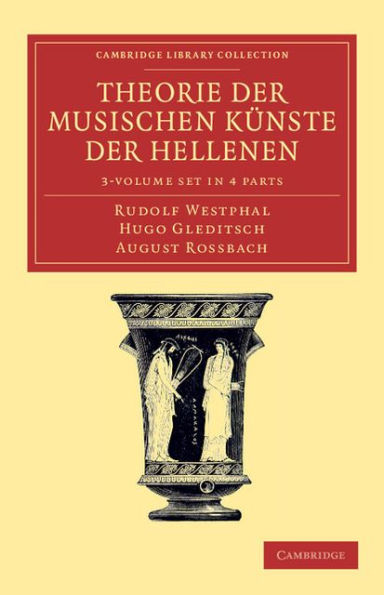Theorie der musischen Künste der Hellenen 3 Volume Set in 4 parts
Rudolf Westphal (1826─92) originally studied theology at the University of Marburg before turning to classical philology and comparative linguistics. He learnt Sanskrit and Arabic and took a keen interest in Indo-European languages and Semitic grammar. In the late 1850s and early 1860s he joined his friend and fellow philologist August Rossbach (1823–98) at the University of Breslau (Wrocław). This multi-volume work on ancient Greek metre and music resulted from their collaboration. Reissued here is the revised third edition published in four parts between 1885 and 1889. Volume 1 (1885) is devoted to rhythm while Volume 2 (1886) looks at melody and harmony. Part 1 of Volume 3 (1887) explores prosody and the distinction drawn by the philosopher Aristoxenus between singing and speaking, while Part 2 (1889) considers the historical development of different metres and analyses a number of lyrical and choral compositions in great detail.
1139734672
Theorie der musischen Künste der Hellenen 3 Volume Set in 4 parts
Rudolf Westphal (1826─92) originally studied theology at the University of Marburg before turning to classical philology and comparative linguistics. He learnt Sanskrit and Arabic and took a keen interest in Indo-European languages and Semitic grammar. In the late 1850s and early 1860s he joined his friend and fellow philologist August Rossbach (1823–98) at the University of Breslau (Wrocław). This multi-volume work on ancient Greek metre and music resulted from their collaboration. Reissued here is the revised third edition published in four parts between 1885 and 1889. Volume 1 (1885) is devoted to rhythm while Volume 2 (1886) looks at melody and harmony. Part 1 of Volume 3 (1887) explores prosody and the distinction drawn by the philosopher Aristoxenus between singing and speaking, while Part 2 (1889) considers the historical development of different metres and analyses a number of lyrical and choral compositions in great detail.
214.0
In Stock
5
1

Theorie der musischen Künste der Hellenen 3 Volume Set in 4 parts
2022
Theorie der musischen Künste der Hellenen 3 Volume Set in 4 parts
2022
$214.00
214.0
In Stock

Product Details
| ISBN-13: | 9781108061537 |
|---|---|
| Publisher: | Cambridge University Press |
| Publication date: | 06/27/2013 |
| Series: | Cambridge Library Collection - Classics |
| Pages: | 2022 |
| Product dimensions: | 5.90(w) x 8.80(h) x 4.90(d) |
| Language: | German |
From the B&N Reads Blog
